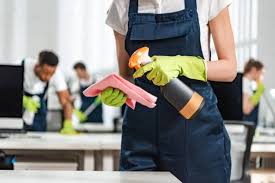A clean office isn’t just a bonus—it’s a basic requirement for any productive and professional workplace. Whether you’re managing a busy city firm or a suburban small business, a well-maintained workspace can affect everything from employee wellbeing to how clients perceive your organisation. But what does “clean” really mean in a practical sense?
Understanding the frequency and scope of cleaning tasks is the first step to maintaining hygiene standards without wasting resources. This office cleaning checklist breaks down the daily, weekly, and monthly duties that keep workspaces looking sharp and feeling fresh.
Why a Structured Cleaning Schedule Matters
Think about the number of hands that touch the same door handles, desks, keyboards, and kitchen appliances every day. Without a clear plan, it’s easy to miss important cleaning tasks or overdo others. This leads to either unhygienic environments or wasted effort.
A consistent Office Cleaning routine does more than maintain appearances—it prevents illness, reduces staff absenteeism, and boosts morale. It also signals to clients that your business values professionalism and attention to detail.
Daily Office Cleaning Tasks
The key focus for daily cleaning is hygiene and visual order. These jobs keep germs at bay and ensure employees start their day in a tidy space.
- Empty bins and replace liners: Office bins fill quickly and can attract pests if not emptied daily.
- Wipe down high-touch surfaces: Desks, keyboards, phones, door handles, and light switches need daily disinfecting.
- Clean kitchen surfaces: Wipe benches, coffee machines, sinks, and fridge handles. These are hotspots for bacteria.
- Tidy shared spaces: Reception areas, waiting rooms, and break rooms should always look ready for visitors.
- Vacuum or sweep high-traffic areas: Dirt and debris build up fast, especially near entry points.
Maintaining these tasks daily reduces deep cleaning time and keeps everything sanitary between more intensive cleans.
Weekly Office Cleaning Tasks
Weekly cleaning goes a step deeper. These tasks target areas that don’t need constant attention but still require regular upkeep.
- Vacuum all floors thoroughly, including under furniture
- Mop hard floors: Especially in kitchens, bathrooms, and entryways.
- Disinfect bathrooms: Including toilets, sinks, taps, mirrors, and floors. Top up supplies like toilet paper and soap.
- Dust shelves, window sills, blinds, and baseboards
- Clean inside the microwave and other kitchen appliances
- Polish glass surfaces and interior windows
A reliable Office Cleaning provider will ensure these tasks are consistently done, which makes a noticeable difference in workplace cleanliness.
Monthly Office Cleaning Tasks
Monthly tasks are more in-depth and help preserve the longevity of office assets. They also address areas that might be neglected during daily or weekly cleans.
- Wipe down walls and doors: Marks, scuffs, and smudges accumulate slowly but affect overall appearance.
- Deep clean carpets and upholstery: Dirt sinks deep into fabric over time. Regular vacuuming isn’t enough.
- Clean vents and air conditioning filters: These collect dust and impact indoor air quality.
- Wash windows inside and out: Clear windows improve natural light and lift the office atmosphere.
- Organise and clean out kitchen cupboards and fridges
- Test and clean emergency exits and equipment
These monthly efforts prevent long-term damage and maintain workplace health and safety standards.
Overlooked Cleaning Areas That Need Attention
Despite best efforts, some office zones are easy to forget. Don’t skip:
- Chair arms and backs
- Printer and copier touchscreens
- Light fixtures
- Shared tech such as remote controls and presentation tools
Regular checks ensure these high-use, low-notice items don’t become hygiene hazards.
Signs You Need to Adjust Your Office Cleaning Routine
Even with a schedule in place, office needs can shift. Keep an eye out for signs that your cleaning routine may need tweaking:
- Employees reporting allergies or frequent illness
- Complaints about odours or visual mess
- Build-up of dust or grime in unexpected spots
- Missed cleaning tasks due to time or resource limitations
A proactive approach will keep your workplace efficient and your employees healthier.
Why Professional Help Makes a Difference
Hiring professional services means you’re not relying on staff to handle complex cleaning tasks or guess at proper hygiene protocols. Expert cleaners use commercial-grade equipment, effective products, and proven processes. They’re trained to meet standards across sectors—whether it’s hospitality, education, or corporate settings.
Plus, they can build a cleaning schedule that suits your specific space, usage, and foot traffic—whether you need Office Cleaning support daily, weekly, or on-call for high-pressure situations.
According to Safe Work Australia, maintaining workplace cleanliness isn’t just good practice—it’s part of a broader commitment to health and safety.
Final Thoughts
A structured cleaning checklist keeps your workspace functional, fresh, and inviting. It reduces the spread of illness, lifts morale, and makes a lasting impression on clients. By aligning cleaning frequency with actual needs, your business can keep things spotless without overspending.
If your current cleaning setup feels reactive rather than planned, it may be time to bring in experts who can support a proactive strategy. Office Cleaning services can help maintain consistent quality across your office—without the headache.
Want to make your workplace healthier, more organised, and better presented? Start with the checklist above. Your team—and your bottom line—will thank you.

